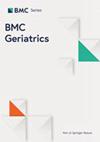Creatinine-to-cystatin C ratio and frailty in older adults: a longitudinal cohort study
IF 3.4
2区 医学
Q2 GERIATRICS & GERONTOLOGY
引用次数: 0
Abstract
Creatinine-to-cystatin C ratio (CCR) has been associated with multiple adverse outcomes. However, little is known about its relationship with frailty. We aimed to explore the association between CCR and frailty among older adults. A total of 2599 participants aged ≥ 60 years (mean age 67.9 ± 6.0 years, 50.4% males) were included from the China Health and Retirement Longitudinal Study (2011–2015). Baseline CCR was calculated as plasma creatinine (mg/dL) / cystatin C (mg/L) × 10 and was grouped by quartiles. Frailty was evaluated by the validated physical frailty phenotype (PFP) scale and was defined as PFP score ≥ 3. The generalized estimating equations model was used to explore the relationship between CCR and frailty. The frailty risk decreased gradually with increasing CCR in the quartiles (P for trend = 0.002), and the fourth CCR quartile was associated with a significantly lower risk of frailty compared with the lowest quartile (odds ratio [OR] 0.37, 95% confidence interval [CI] 0.19–0.70). When modeling as a continuous variable, per 1-unit increase in CCR was related to 17% decreased odds of frailty (OR 0.83, 95% CI 0.74–0.93). The association was consistent in male and female participants (P for interaction = 0.41). Poisson models revealed that frailty score was negatively associated with CCR (β= -0.11, 95% CI= -0.19 to -0.04), and sex did not significantly moderate the associations (P for interaction = 0.22). The results were not affected by further adjusting for high-sensitivity C-reactive protein. Similar results were observed by analyses with multiple imputation technique and analyses excluding participants with baseline frailty. Higher CCR was associated with a lower frailty risk. CCR may be a simple marker for predicting frailty in older adults.老年人肌酐-胱抑素 C 比率与虚弱:纵向队列研究
肌酐-胱抑素 C 比值(CCR)与多种不良后果有关。然而,人们对其与虚弱之间的关系知之甚少。我们旨在探讨 CCR 与老年人虚弱之间的关系。中国健康与退休纵向研究(2011-2015 年)共纳入了 2599 名年龄≥ 60 岁的参与者(平均年龄为 67.9 ± 6.0 岁,男性占 50.4%)。基线CCR的计算方法为血浆肌酐(mg/dL)/胱抑素C(mg/L)×10,并按四分位数分组。体质虚弱通过有效的体质虚弱表型(PFP)量表进行评估,PFP评分≥3分即为体质虚弱。采用广义估计方程模型来探讨 CCR 与虚弱之间的关系。随着 CCR 四分位数的增加,虚弱风险逐渐降低(趋势 P = 0.002),与最低四分位数相比,CCR 四分位数的第四位与显著降低的虚弱风险相关(几率比 [OR] 0.37,95% 置信区间 [CI]0.19-0.70)。如果作为连续变量建模,CCR 每增加 1 个单位与虚弱几率降低 17% 有关(OR 0.83,95% CI 0.74-0.93)。男女参与者的相关性一致(交互作用 P = 0.41)。泊松模型显示,虚弱评分与 CCR 呈负相关(β= -0.11,95% CI=-0.19--0.04),而性别并没有显著调节相关性(交互作用 P = 0.22)。进一步调整高敏 C 反应蛋白后,结果不受影响。使用多重估算技术进行分析和排除基线虚弱参与者的分析也观察到了类似的结果。较高的 CCR 与较低的虚弱风险相关。CCR可能是预测老年人虚弱的一个简单标记。
本文章由计算机程序翻译,如有差异,请以英文原文为准。
求助全文
约1分钟内获得全文
求助全文
来源期刊

BMC Geriatrics
GERIATRICS & GERONTOLOGY-
CiteScore
5.70
自引率
7.30%
发文量
873
审稿时长
20 weeks
期刊介绍:
BMC Geriatrics is an open access journal publishing original peer-reviewed research articles in all aspects of the health and healthcare of older people, including the effects of healthcare systems and policies. The journal also welcomes research focused on the aging process, including cellular, genetic, and physiological processes and cognitive modifications.
 求助内容:
求助内容: 应助结果提醒方式:
应助结果提醒方式:


